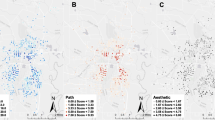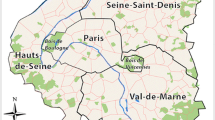Abstract
Recent research in urban planning and public health has drawn attention to the associations between urban form and physical activity in adults. Because little is known on the urban–rural differences in physical activity, the main aims of the present study were to examine differences in physical activity between urban and rural adults and to investigate the moderating effects of the physical environment on the relationship between psychosocial factors and physical activity. In Flanders, Belgium, five rural and five urban neighborhoods were selected. A sample of 350 adults (20–65 years of age; 35 adults per neighborhood) participated in the study. Participants wore a pedometer for 7 days, and self-reported physical activity and psychosocial data were also collected. Results showed that urban adults took more steps/day and reported more walking and cycling for transport in the neighborhood, more recreational walking in the neighborhood, and more walking for transportation outside the neighborhood than rural adults. Rural adults reported more recreational cycling in the neighborhoods. The physical environment was a significant moderator of the associations between several psychosocial factors (modeling from family, self-efficacy, and perceived barriers) and physical activity. In rural participants, adults with psychosocial scores above average were more physically active, whereas there were no differences in physical activity according to psychosocial factors in urban participants. These results are promising and plead for the development of multidimensional interventions, targeting specific population subgroups. In rural environments, where changing the environment would be a very challenging task, interventions focusing on modifiable psychosocial constructs could possibly be effective.

Similar content being viewed by others
References
European Commission. Eurobarometer physical activity, special eurobarometer 183-6, Wave 58.2, European Opinion Research Group EEIG, Directorate General Health and Consumer Protection and Directorate General Press and Communication. 2003; 1–49.
Haskell WL, Min Lee I, Pate RR, et al. Physical activity and public health: updated recommendation for adults from the American College of Sports Medicine and the American Heart Association. Med Sci Sports Exerc. 2007; 39(8): 1423–1434.
US Department of Health and Human Services. Physical activity and health: a report of the Surgeon General. Atlanta, GA: US Department of Health and Human Services, Centers for Disease Control and Prevention, National Center for Chronic Disease Prevention and Health Promotion; 1996.
Spence JC, Lee RE. Toward a comprehensive model of physical activity. Psychol Sport Exerc. 2003; 4(1): 7–24.
Sallis JF, Owen N, Fisher EB. Ecological models of health behavior. In: Glanz K, Rimer BK, Viswanath K, eds. Health behavior and health education: theory, research and practice. San Francisco: Jossey-Bass; 2008: 465–486.
Frank LD, Engelke PO, Schmid TL. Health and community design: the impact of the built environment on physical activity. Washington, DC: Island; 2003.
Ewing R, Schmid T, Killingsworth R, Zlot A, Raudenbush S. Relationship between urban sprawl and physical activity, obesity and morbidity. Am J Health Promot. 2003; 18(1): 47–57.
Owen N, Cerin E, Leslie E, et al. Neighborhood walkability and the walking behavior of Australian adults. Am J Prev Med. 2007; 33(5): 387–395.
Sallis JF, Saelens BE, Frank LD, et al. Neighborhood built environment and income: examining multiple health outcomes. Soc Sci Med. 2009; 68(7): 1285–1293.
Van Dyck D, Cardon G, Deforche B, Sallis JF, Owen N, De Bourdeaudhuij I. Neighborhood SES and walkability are related to physical activity behaviour in Belgian adults. Prev Med. 2010; 50(S1): S74–S77.
Saelens BE, Sallis JF, Frank LD. Environmental correlates of walking and cycling: findings from transportation, urban design and planning literatures. Ann Behav Med. 2003; 25(2): 80–91.
Handy SL, Boarnet MG, Ewing R, Killingsworth RE. How the built environment affects physical activity: views from urban planning. Am J Prev Med. 2002; 23(2): 64–73.
Savitch HV. How suburban sprawl shapes human well-being. J Urban Health. 2003; 80(4): 590–607.
Frank LD. Land use and transportation interaction: implications on public health and quality of life. J Planning Educ Research. 2000; 20(1): 6–22.
Leslie E, McCrea R, Cerin E, Stimson R. Regional variations in walking for different purposes: the South East Queensland quality of life study. Environ Behav. 2007; 39(4): 557–577.
Joshu CE, Boehmer TK, Brownson RC, Ewing R. Personal, neighbourhood and urban factors associated with obesity in the United States. J Epidemiol Community Health. 2008; 62(3): 202–208.
Wilcox S, Castro C, King AC, Housemann R, Ross C. Determinants of leisure time physical activity in rural compared with urban older and ethnically diverse women in the United States. J Epidemiol Community Health. 2000; 54(9): 667–672.
Reis JP, Bowles HR, Ainsworth BE, Dubose KD, Smith S, Laditka JN. Nonoccupational physical activity activity by degree of urbanization and US geographic region. Med Sci Sports Exerc. 2004; 36(12): 2093–2098.
Eyler AA, Brownson RC, Bacak SJ, Housemann RA. The epidemiology of walking for physical activity in the United States. Med Sci Sports Exerc. 2003; 35(9): 1529–1536.
Denavas-Walt C, Proctor BD, Smith JC. Census Bureau, current population reports, 60–236, income poverty, and health insurance coverage in the United States: 2008, US Washington, DC: US Government Printing Office; 2009.
Trost SG, Owen N, Bauman AE, Sallis JF, Brown W. Correlates of adults’ participation in physical activity: review and update. Med Sci Sports Exerc. 2002; 34(12): 1996–2001.
Arnadottir SA, Gunnarsdottir ED, Lundin-Olsson L. Are rural older Icelanders less physically active than those living in urban areas? A population-based study. Scand J Public Health. 2009; 37(4): 409–417.
National Intitute of Statistics (Belgium), 2008: www.statbel.fgov.be, FOD Economie-Algemene Directie Statistiek.
Parks SE, Housemann RA, Brownson RC. Differential correlates of physical activity in urban and rural adults of various socioeconomic backgrounds in the United States. J Epidemiol Community Health. 2003; 57(1): 29–35.
Van Dyck D, Deforche B, Cardon G, De Bourdeaudhuij I. Neighbourhood walkability and its particular importance for adults with a preference for passive transport. Health Place. 2009; 15(2): 496–504.
Leslie E, Coffee N, Frank L, Owen N, Bauman A, Hugo G. Walkability of local communities: using geographic information systems to objectively assess relevant environmental attributes. Health Place. 2007; 13(1): 111–122.
Giles-Corti B, Timperio A, Cutt H, et al. Development of a reliable measure of walking within and outside the local neighbourhood: RESIDE’s Neighborhood Physical Activity Questionnaire. Prev Med. 2006; 42(6): 455–459.
De Bourdeaudhuij I, Sallis JF. Relative contribution of psychosocial variables to the explanation of physical activity in three population-based adult samples. Prev Med. 2002; 34(2): 279–288.
Welk GJ, Differding JA, Thompson RW, Blair SN, Dziura J, Hart P. The utility of the Digi-Walker step counter to assess daily physical activity patterns. Med Sci Sports Exerc. 2000; 32(9): S481–S488.
Schneider PL, Crouter SE, Lukajic O, Bassett DR. Accuracy and reliability of 10 pedometers for measuring steps over a 400-m walk. Med Sci Sports Exerc. 2003; 35(10): 1779–1784.
De Cocker K, Cardon G, De Bourdeaudhuij I. Pedometer-determined physical activity and its comparison with the International Physical Activity Questionnaire in a sample of Belgian adults. Res Q Exerc Sport. 2007; 78(5): 429–437.
Miller R, Brown W, Tudor-Locke C. But what about swimming and cycling? How to count non-ambulatory activity when using pedometers to assess physical activity? J Phys Act Health. 2006; 3(3): 257–266.
Tudor-Locke C, Ham SA, Macera CA, et al. Descriptive epidemiology of pedometer-determined physical activity. Med Sci Sports Exerc. 2004; 36(9): 1567–1573.
Craig CL, Marshall AL, Sjöström M, et al. International Physical Activity Questionnaire: 12-country reliability and validity. Med Sci Sports Exerc. 2003; 35(8): 1381–1395.
Deforche B, De Bourdeaudhuij I, Tanghe A, Hills AP, De Bode P. Changes in physical activity and psychosocial determinants of physical activity in children and adolescents treated for obesity. Patient Educ Couns. 2004; 55(3): 407–415.
De Bourdeaudhuij I, Lefevre J, Deforche B, Wijndaele K, Matton L, Philippaerts R. Physical activity and psychosocial correlates in normal and overweight 11 to 19 year olds. Obes Rev. 2005; 13(6): 1097–1105.
Keene ON. The log transformation is special. Stat Med. 1995; 14(8): 811–819.
Vojnovic I. Building communities to promote physical activity: a multi-scale geographical analysis. Geogr Ann. 2006; 88(1): 67–90.
Giles-Corti B. People or places, what should be the target? J Sci Med Sport. 2006; 9(5): 357–366.
Booth M, Owen N, Bauman A, Clavisi O, Leslie E. Social-cognitive and perceived environmental factors associated with physical activity in older Australians. Prev Med. 2000; 31(1): 15–22.
Author information
Authors and Affiliations
Corresponding author
Rights and permissions
About this article
Cite this article
Dyck, D.V., Cardon, G., Deforche, B. et al. Urban–Rural Differences in Physical Activity in Belgian Adults and the Importance of Psychosocial Factors. J Urban Health 88, 154–167 (2011). https://doi.org/10.1007/s11524-010-9536-3
Published:
Issue Date:
DOI: https://doi.org/10.1007/s11524-010-9536-3




